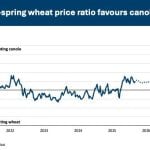Alberta
Crop conditions are generally good to excellent in most areas.
Harvest is underway and expected to be in full progress soon.
Heavy rain, cooler weather and hail storms have delayed haying operations in some areas and affected quality.
However, overall hay quality is good to excellent.
Sub-surface moisture conditions have greatly improved and are in excellent condition.
South
The region experienced scattered hail storms that caused light to heavy damage in localized areas.
Most of the spring wheat, canola, barley, oats and dry peas are in good to excellent condition.
Read Also

Farm Credit Canada partners with major Toronto innovation hub
A FCC parntership with MaRS Discovery District aims to solve technology problems in food supply chains.
Harvest of winter wheat, dry peas and fall rye has begun. Producers have also started swathing spring wheat, barley, and canola.
Yield potentials are generally above average.
Rain, hail storms and cooler weather affected hay quality.
First-cut haying for dryland and irrigated land is done and generally rated as good to excellent. Second-cut haying is underway.
Central
Most areas received damp and cooler weather, as well as localized hail storms, which caused some crop damage.
Sub-surface soil moisture conditions are good to excellent.
Despite the recent precipitation and hail storms, crops are generally rated as good to excellent, thanks to warmer weather.
Among major crops, most of the spring wheat, barley, oats and canola are in good to excellent condition. Early yield estimates are generally above average.
Most of the tame hay and pasture growth is in good to excellent condition.
North
Despite the cool and damp weather, crop growing conditions continue to be favourable across the region.
Precipitation during the past two weeks has ranged from 10 to 50 millimetres in most areas of the region. Minor crop damage was caused by scattered hail storms.
Major crops and sub-surface soil moisture conditions are good to excellent.
Showers and cooler weather in most parts have affected haying operations and quality. Most first-cut hay is complete with good quality. Most tame hay and pasture conditions are rated good to excellent.
Peace
The region received below 30 mm of precipitation in most areas. Due to damp and cool weather, there has been a three-point decline in crop conditions.
However, spring wheat, barley, oats and canola remain in good to excellent condition.
Sub-surface soil moisture conditions are also good to excellent.
Rainfall and cooler weather has slowed first-cut haying operations and lowered quality. Tame hay and pasture growth are rated as good to excellent. Grasshoppers and lygus bugs are a moderate to severe problem in some parts.
Saskatchewan
South
Harvest operations have just started for some producers with desiccation of peas and lentils and swathing of winter cereals.
Winter wheat and fall rye crops are ready to straight cut in some areas.
Lack of rainfall has matured crops more quickly in some southern areas than in the rest of the province.
The Briercrest area recorded the highest amount of rainfall with 58 mm.
Haying in the southeast is challenging because of frequent showers and heavy dew.
In the southwest, haying is near completion.
Hay yields throughout the regions vary from 0.5 tons per acre to 3.3 tons per acre on dryland brome/alfalfa stands.
Topsoil moisture conditions are very good on cropland and hayland.
There are reports of crop damage due to insects, flooding, disease and some hail.
Ascochyta blight, tan spot, bertha armyworms and grasshoppers are causing the majority of crop damage.
Central
While crops are about two weeks behind normal, there are reports of winter cereals, lentils and peas ready to straight cut and a few fields of canola being swathed.
Pulses are being desiccated in some areas as well.
Most areas recorded some welcome rainfall with the Kindersley area topping the region with 52 mm.
Hay yields range from 0.33 to 2.8 tons per acre on dryland brome/alfalfa stands.
Cropland and hayland is generally in good condition, however the western areas are much drier.
Dry conditions, bertha armyworm and grasshoppers are causing the majority of crop damage.
North
Continued heat should advance crop maturity in a region that’s behind for this time of year.
Less rain in some eastern areas during the last two weeks has allowed for field conditions to dry and relieve some moisture stress of crops.
However, other areas have not received significant rain over the past few weeks so crops are showing signs of stress.
Most crops are in the podding and filling stages of development with some later seeded crops done flowering. Some pea crops may be soon ready for desiccation and there are reports of some cereal crops starting to turn.
The Lloydminster area received the highest amount of rainfall with 32 mm.
Hay yields range from one to 3.5 tons per acre on dryland brome/alfalfa stands. Greenfeed crops are being cut.
Most topsoil moisture on cropland and hayland is estimated to be in adequate condition.
Reported crop damage is attributed to bertha armyworms, fusarium and dry conditions.
Grasshoppers have also reached economic thresholds for spraying in some cases and control is being warranted. Lygus bugs are showing up in canola as well.
Manitoba
Southwest
After weeks of cool temperatures, warmer weather returned in mid-August. Daily highs near 30 C should accelerate crop development for soybeans and corn.
Grasshoppers remain the primary insect pest in the eastern and central portions of the region.
Hay yields are slightly below normal or average. Cereal silage yields reported as average.
Central
Winter wheat harvest is well underway or complete. Growers have reported yields from 75 to 100 bushels per acre. Fusarium in winter wheat is low and protein content is above average.
Canola swathing continues and yield potential looks promising.
As of mid-August, many fields in Manitoba were still in bloom. Warmer temperatures should terminate canola flowering phase.
Provincial disease survey indicates that blackleg levels are lower than 2012. Sclerotinia pressure is higher than last year.
Northwest
Cool weather in late July and early August favoured canola and cereal development.
Canola pod filling and cereal grain filling are rated as good.
Soybeans are progressing slowly but disease reports are minimal. Pasture conditions are rated as good.
Eastern
Growers are reporting root rot in soybean fields but economic impact is limited. Roundup Ready canola volunteers are present in many soybean fields this year.
White mould is present in edible bean fields but the crop is rated as good. Warmer, drier weather should alleviate white mould pressure.
Hay, straw and feed grain supplies are rated as adequate or surplus. Dugout levels are sufficient.
Interlake
Spring cereals continue to ripen but harvest remains a few weeks away. Producers are starting to apply preharvest dessicant in the southern portion of the Interlake. Growers are reporting above average yields from silage harvest. Pasture and dugout conditions are rated as good.














